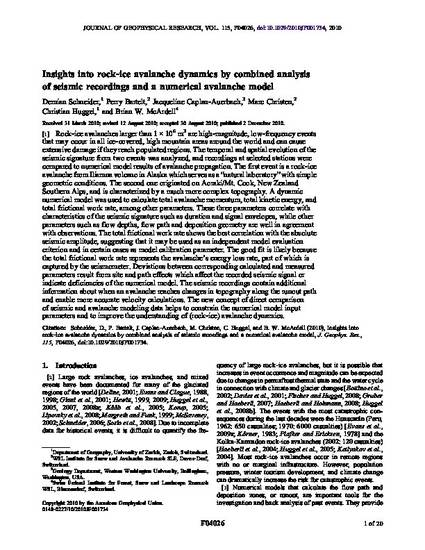
- Rock-ice avalances,
- Seismic recordings,
- Iliamna volcano,
- Aoraki/Mt. Cook
Rock‐ice avalanches larger than 1 × 106 m3 are high‐magnitude, low‐frequency events that may occur in all ice‐covered, high mountain areas around the world and can cause extensive damage if they reach populated regions. The temporal and spatial evolution of the seismic signature from two events was analyzed, and recordings at selected stations were compared to numerical model results of avalanche propagation. The first event is a rock‐ice avalanche from Iliamna volcano in Alaska which serves as a “natural laboratory” with simple geometric conditions. The second one originated on Aoraki/Mt. Cook, New Zealand Southern Alps, and is characterized by a much more complex topography. A dynamic numerical model was used to calculate total avalanche momentum, total kinetic energy, and total frictional work rate, among other parameters. These three parameters correlate with characteristics of the seismic signature such as duration and signal envelopes, while other parameters such as flow depths, flow path and deposition geometry are well in agreement with observations. The total frictional work rate shows the best correlation with the absolute seismic amplitude, suggesting that it may be used as an independent model evaluation criterion and in certain cases as model calibration parameter. The good fit is likely because the total frictional work rate represents the avalanche ’s energy loss rate, part of which is captured by the seismometer. Deviations between corresponding calculated and measured parameters result from site and path effects which affect the recorded seismic signal or indicate deficiencies of the numerical model. The seismic recordings contain additional information about when an avalanche reaches changes in topography along the runout path and enable more accurate velocity calculations. The new concept of direct comparison of seismic and avalanche modeling data helps to constrain the numerical model input parameters and to improve the understanding of (rock‐ice) avalanche dynamics.
Available at: http://works.bepress.com/jacqueline_caplan-auerbach/5/
